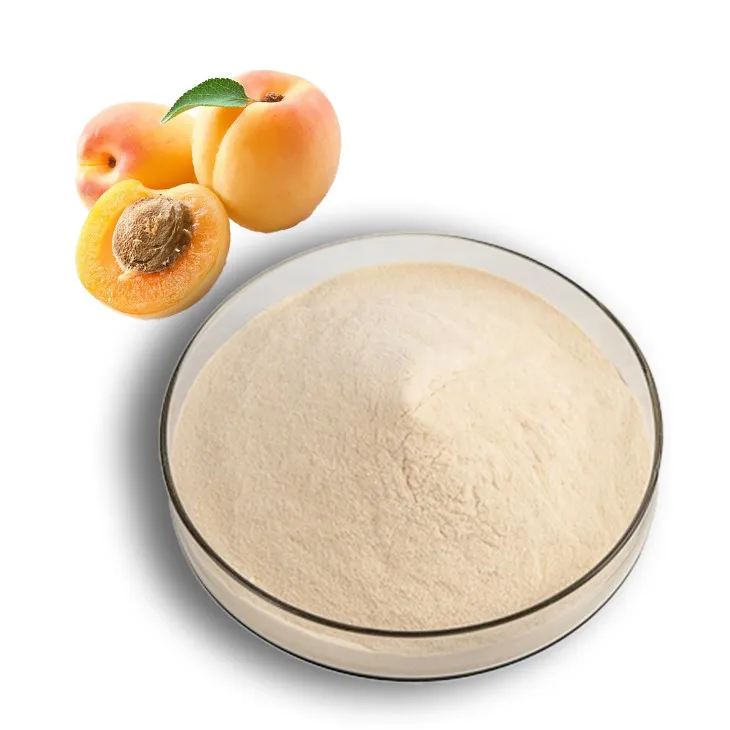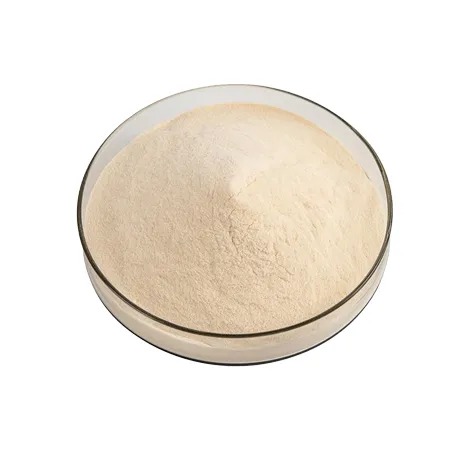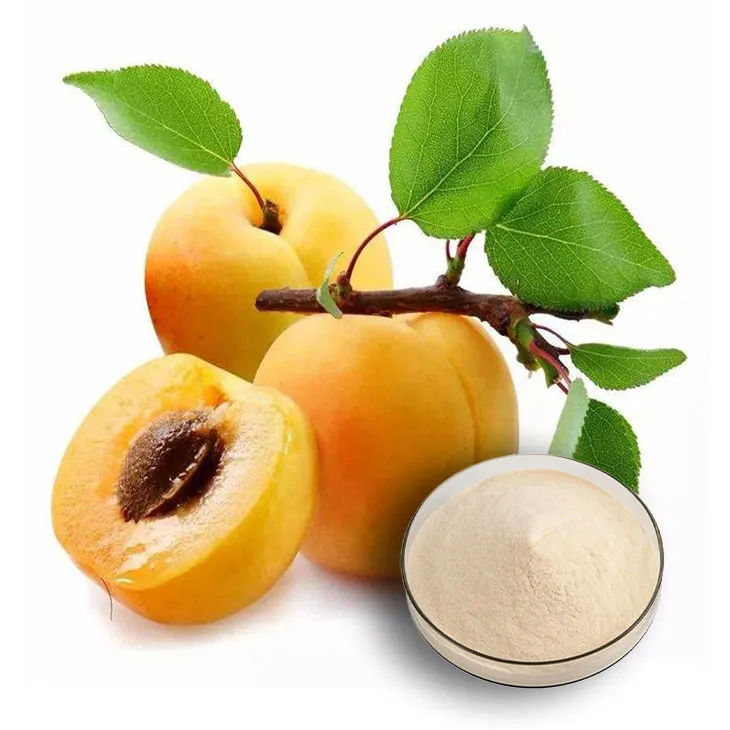- 0086-571-85302990
- sales@greenskybio.com
The process of extracting amygdalin from apricot powder.
2024-11-27

1. Introduction
Apricot kernel powder has been a subject of interest due to the presence of amygdalin. Amygdalin is a compound that has various potential applications in the fields of medicine and chemistry. However, the extraction process is complex and requires careful consideration of multiple factors. This article aims to explore in detail the process of extracting amygdalin from apricot kernel powder, including the initial handling of the powder, the extraction steps, the factors influencing the extraction such as chemical reactions, environmental conditions, and safety aspects.

2. Initial Handling of Apricot Kernel Powder
2.1. Source and Selection
The first step in the extraction process is to ensure the quality of the apricot kernel powder. Apricot kernels should be sourced from reliable suppliers. Different varieties of apricots may have different amygdalin contents. It is important to select kernels that are fresh and free from mold or other contaminants. This can be achieved through visual inspection and, if possible, laboratory testing for purity.
2.2. Grinding and Preparation
Once the appropriate apricot kernels are selected, they need to be ground into a fine powder. This is typically done using a grinder. The fineness of the powder can influence the extraction efficiency. A finer powder generally provides a larger surface area for the extraction solvents to interact with the amygdalin molecules. However, over - grinding may lead to the release of unwanted substances or the degradation of amygdalin. Therefore, it is crucial to find the optimal grinding level.

3. Chemical Reactions Involved in the Extraction
3.1. Solvent - Solute Interaction
The extraction of amygdalin from apricot kernel powder mainly relies on the interaction between the solvent and the solute (amygdalin). Common solvents used for this purpose include ethanol and water - ethanol mixtures. Ethanol is a favorable solvent as it can dissolve amygdalin effectively while having a relatively low toxicity compared to some other organic solvents. When the solvent comes into contact with the apricot kernel powder, the amygdalin molecules are attracted to the solvent molecules due to intermolecular forces such as hydrogen bonding and dipole - dipole interactions.
3.2. Hydrolysis Reactions
During the extraction process, hydrolysis reactions may occur. Amygdalin can be hydrolyzed into benzaldehyde, glucose, and hydrogen cyanide under certain conditions. This hydrolysis can be affected by factors such as the pH of the extraction medium. In an acidic environment, the hydrolysis rate may be accelerated. However, excessive hydrolysis can lead to a decrease in the yield of intact amygdalin. Therefore, it is necessary to control the pH carefully during the extraction process to balance the hydrolysis and extraction efficiency.

4. The Extraction Process Steps
4.1. Soxhlet Extraction
The Soxhlet extraction method is commonly used for amygdalin extraction. In this method:
- Place the apricot kernel powder in a Soxhlet thimble.
- Add the selected solvent (e.g., ethanol) to the Soxhlet apparatus reservoir.
- The solvent is heated and vaporized. The vapor rises and enters the Soxhlet thimble containing the powder, where it extracts the amygdalin.
- The solvent - amygdalin mixture then drips back into the reservoir, and the cycle repeats multiple times to ensure efficient extraction.
4.2. Maceration
Another extraction method is maceration. Here are the steps:
- Place the apricot kernel powder in a container.
- Add the solvent to the container, ensuring that the powder is fully immersed.
- Allow the mixture to stand for a certain period, usually several days to weeks. During this time, the solvent gradually extracts the amygdalin from the powder.
- After the maceration period, the solvent - amygdalin mixture is separated from the remaining solid powder, usually by filtration.
5. Factors Influencing the Extraction
5.1. Temperature
Temperature plays a significant role in the extraction of amygdalin. Increasing the temperature can generally enhance the solubility of amygdalin in the solvent, which may lead to a higher extraction yield. However, too high a temperature can also cause the degradation of amygdalin or the evaporation of the solvent at an excessive rate. For example, in Soxhlet extraction, if the heating temperature is too high, the ethanol solvent may evaporate too quickly, reducing the efficiency of the extraction cycle. Therefore, an optimal temperature range needs to be determined, which is usually around 50 - 70°C for ethanol - based extractions.
5.2. Time
The extraction time also affects the yield of amygdalin. Longer extraction times can increase the amount of amygdalin extracted, but there is a limit. In Soxhlet extraction, after a certain number of cycles, the extraction efficiency may not increase significantly. In maceration, extending the time beyond a certain point may lead to the degradation of amygdalin or the extraction of unwanted substances. Therefore, it is necessary to optimize the extraction time based on the extraction method used.
5.3. Solvent - to - Powder Ratio
The ratio of solvent to apricot kernel powder is an important factor. A higher solvent - to - powder ratio can increase the extraction efficiency as it provides more solvent molecules to interact with the amygdalin in the powder. However, using too much solvent may not be cost - effective and may also require more time for the subsequent separation of the solvent - amygdalin mixture from the powder. A typical solvent - to - powder ratio for ethanol - based extractions may range from 5:1 to 10:1.
6. Environmental Conditions
6.1. Ventilation
Since amygdalin can hydrolyze to produce hydrogen cyanide, which is a toxic gas, good ventilation is essential during the extraction process. In a laboratory or industrial setting, proper ventilation systems should be in place to prevent the accumulation of hydrogen cyanide. This can be achieved through the use of fume hoods or exhaust fans. Adequate ventilation not only protects the operators from the toxic gas but also helps to maintain a stable extraction environment.
6.2. Humidity
Humidity can also affect the extraction process. High humidity may cause the apricot kernel powder to absorb moisture, which can change the physical and chemical properties of the powder. For example, it may lead to the clumping of the powder, reducing the surface area available for extraction. On the other hand, very low humidity may cause the powder to become too dry and brittle, which may also affect the extraction efficiency. Therefore, it is advisable to control the humidity in the extraction environment, usually maintaining it at a relative humidity of around 40 - 60%.
7. Safety Aspects
7.1. Toxicity of Hydrogen Cyanide
As mentioned earlier, the hydrolysis of amygdalin can produce hydrogen cyanide. Hydrogen cyanide is highly toxic and can cause serious harm to human health, including respiratory failure and death. Therefore, during the extraction process, safety measures must be taken to prevent exposure to hydrogen cyanide. Operators should wear appropriate personal protective equipment, such as gas masks and gloves. In addition, in case of accidental release of hydrogen cyanide, emergency response procedures should be in place, such as the use of cyanide - antidote kits.
7.2. Fire and Explosion Hazards
Many of the solvents used in amygdalin extraction, such as ethanol, are flammable. Therefore, fire and explosion hazards must be considered. The extraction area should be free from ignition sources, such as open flames and electrical sparks. Storage of solvents should be in accordance with safety regulations, in well - ventilated and fire - resistant storage areas. Fire extinguishing equipment, such as fire extinguishers and sprinkler systems, should be readily available in the extraction area.
8. Conclusion
The extraction of amygdalin from apricot kernel powder is a complex process that involves multiple steps and factors. From the initial handling of the apricot kernel powder to the final extraction, each stage requires careful attention. Chemical reactions, environmental conditions, and safety aspects all play crucial roles in determining the success of the extraction. By understanding and optimizing these factors, it is possible to achieve a more efficient and safe extraction of amygdalin, which can contribute to further research and applications in relevant fields.
FAQ:
What are the main chemical reactions involved in the extraction of amygdalin from apricot kernel powder?
The extraction of amygdalin from apricot kernel powder may involve several chemical reactions. One of the key reactions is related to the solubility properties of amygdalin. Solvents are used to dissolve amygdalin from the powder matrix. For example, if a polar solvent is used, it interacts with the polar groups of amygdalin molecules through intermolecular forces such as hydrogen bonding, allowing the amygdalin to be separated from other components in the apricot kernel powder. Additionally, there may be some minor chemical interactions with other substances present in the powder that need to be carefully controlled to ensure a pure extraction of amygdalin.
How does environmental temperature affect the extraction process?
Environmental temperature can have a significant impact on the extraction of amygdalin from apricot kernel powder. Higher temperatures generally increase the rate of dissolution of amygdalin in the solvent. This is because at higher temperatures, the kinetic energy of the molecules (both of the solvent and the amygdalin) is increased. As a result, the solvent molecules can more effectively interact with and break the intermolecular forces holding the amygdalin in the powder. However, if the temperature is too high, it may also lead to the degradation of amygdalin or the extraction of unwanted by - products. On the other hand, lower temperatures may slow down the extraction process as the solubility and the molecular movement are reduced.
What safety precautions should be taken during the extraction?
During the extraction of amygdalin from apricot kernel powder, several safety precautions are necessary. Firstly, since apricot kernels may contain trace amounts of toxic substances, proper handling and protection equipment such as gloves and masks should be used to prevent inhalation or skin contact. Secondly, when using solvents, especially if they are flammable or volatile, appropriate ventilation should be ensured in the extraction area to avoid the build - up of solvent vapors which could pose a fire or explosion hazard. Also, any waste generated during the extraction, including used solvents and leftover powder, should be disposed of according to relevant environmental regulations to prevent environmental pollution.
What are the typical solvents used for amygdalin extraction?
Some of the typical solvents used for amygdalin extraction from apricot kernel powder include ethanol and water - based solvents. Ethanol is a popular choice because it has a relatively good solubility for amygdalin and can also help in reducing the extraction of some unwanted components. Water - based solvents can also be used, especially when combined with certain additives or in a specific pH range. The choice of solvent depends on various factors such as the purity of the final product desired, the cost - effectiveness of the solvent, and its compatibility with the subsequent purification steps.
How can the purity of the extracted amygdalin be determined?
The purity of the extracted amygdalin can be determined through several methods. One common method is chromatography, such as high - performance liquid chromatography (HPLC). HPLC can separate the amygdalin from other components in the extract based on their different chemical properties and retention times. By comparing the peak area or height of the amygdalin peak with known standards, the concentration and purity of amygdalin can be quantified. Spectroscopic methods, such as ultraviolet - visible (UV - Vis) spectroscopy, can also be used. Amygdalin has characteristic absorption wavelengths in the UV - Vis range, and by measuring the absorbance at these wavelengths and comparing with calibration curves, the purity can be estimated.
Related literature
- Amydalin Extraction: Novel Approaches and Their Efficiency"
- "The Chemistry behind Amygdalin Extraction from Apricot Kernels"
- "Environmental and Safety Considerations in Amygdalin Extraction Processes"
- ▶ Hesperidin
- ▶ Citrus Bioflavonoids
- ▶ Plant Extract
- ▶ lycopene
- ▶ Diosmin
- ▶ Grape seed extract
- ▶ Sea buckthorn Juice Powder
- ▶ Fruit Juice Powder
- ▶ Hops Extract
- ▶ Artichoke Extract
- ▶ Mushroom extract
- ▶ Astaxanthin
- ▶ Green Tea Extract
- ▶ Curcumin
- ▶ Horse Chestnut Extract
- ▶ Other Product
- ▶ Boswellia Serrata Extract
- ▶ Resveratrol
- ▶ Marigold Extract
- ▶ Grape Leaf Extract
- ▶ New Product
- ▶ Aminolevulinic acid
- ▶ Cranberry Extract
- ▶ Red Yeast Rice
- ▶ Red Wine Extract
-
melatonin extract
2024-11-27
-
Rose Hip Extract
2024-11-27
-
Agaricus Blazei Extract
2024-11-27
-
Carrageenan Extract Powder
2024-11-27
-
Alfalfa Meal
2024-11-27
-
Panax Ginseng Leaf Extract
2024-11-27
-
Chaste Berry Extract
2024-11-27
-
Konjac Powder
2024-11-27
-
Hericium erinaceus extract powder
2024-11-27
-
Milk Thistle Extract
2024-11-27





















